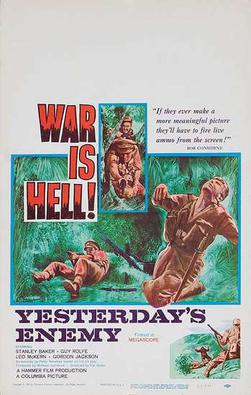“Yesterday’s Enemy” is a Hammer Film that was nominated for four BAFTA’s! It was directed by Val Guest (“The Camp on Blood Island”) in five weeks on a soundstage. It has no musical score. The screenplay was based on a teleplay. The writer was inspired by an alleged war crime involving a British officer. It was nominated for Best Film (“Ben Hur” won), Best British Film (“Sapphire”) and Best Actor – Stanley Baker and Gordon Jackson. It is considered by many, including Stanley himself, to be one of Baker’s best roles.
The movie is set in the Burma Campaign in WWII. A British unit is struggling through a jungle swamp. They are exhausted and have several wounded on stretchers. One of the wounded is their major, so Capt. Langford (Baker) is in command. They arrive at a native village and take more losses in eliminating the Japanese garrison. They find a map that could be valuable. They take a collaborator prisoner and Langford is determined to get him to reveal what the map shows. He threatens to execute two villagers to get the collaborator to talk. The padre (Guy Rolfe), the doctor (David Oxley), and a war correspondent (Leo McKern) argue that the executions would be a war crime. They offer good arguments, but Langford’s response is: “There’s only one way to fight a war – with the gloves off.” He finds out the map shows an upcoming Japanese counteroffensive. They must get the information back to headquarters, but the radio is not working and a Japanese force is closing in on the village.
“Yesterday’s Enemy” is a thought-provoking film that takes itself too seriously. It was clearly meant to tread on ground seldom seen in a British war movie. The two sides of the coin are well represented. There is a lot of talking for a war film, but it is necessary to flesh out the topic of does the end justify the means in warfare. Although the dialogue reminds one that the movie was based on a play, it does have some good action. The set is surprisingly junglelike and although there is no musical score, the sound effects are appropriate. The acting is stellar, as is to be expected of the cast. Baker was always ready to take chances and here he plays an anti-hero that would be more at home in a 1960’s war movie. In fact, the movie is ahead of its time and given the controversial subject of British war crimes, it could not have been made in the 1940’s. Another clue that it is not a 1940’s movie is the Japanese are not demonized and the Japanese leader reminds Langford of British actions in colonial Africa. Touche! It tells you something about the British public that the movie was a big hit. And obviously, it got some critical acclaim. Deservedly so.
GRADE = B

.jpg)
